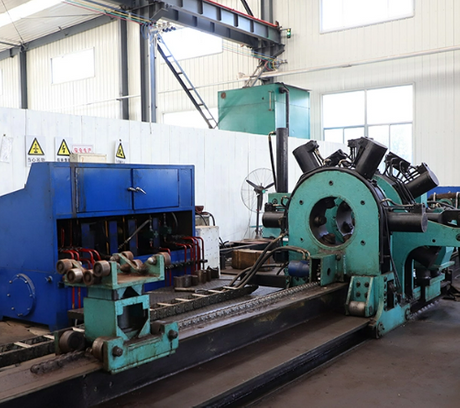Are you tired of dealing with slow drilling in tough terrains? Mud motors are the solution you've been looking for. These powerful tools offer unmatched efficiency and control, especially in challenging environments.
In this post, we'll explore the benefits of using a mud motor, why they're a must-have for drilling operations, and how to choose the right one for your needs. You'll also learn about the different types of mud motors and their specific applications.
What is a Mud Motor in Drilling?
Definition
A mud motor is a specialized rotary drilling tool that uses hydraulic power from the drilling fluid (often referred to as "mud") to turn the drill bit. Unlike traditional rotary systems, a mud motor operates independently of the drill string, providing the rotational power needed for drilling. This makes it particularly valuable for directional drilling operations, where precise control and high torque are required.
How it Works
Mud motors convert hydraulic energy into mechanical energy to rotate the drill bit. The drilling fluid is pumped down the drill string, passing through the motor where it activates the rotor inside. The rotor turns a drive shaft, which in turn rotates the drill bit. This method provides high torque, allowing the drill bit to operate efficiently in hard rock or challenging formations. Mud motors can be used in various configurations, including positive displacement motors (PDM) and turbine motors, each offering different performance characteristics based on the needs of the drilling operation.
In directional drilling, the mud motor is particularly useful. It allows for changes in the well's trajectory without needing to remove the entire drill string. This flexibility is crucial for drilling curved or horizontal wells, making the operation faster and more cost-effective.
Comparison to Conventional Drilling Methods
Mud motors differ significantly from traditional rotary systems like rotary tables and top-drive units. In conventional drilling, the entire drill string is rotated by a rotary table or top-drive, meaning the entire length of the pipe must be turned to rotate the bit. However, with a mud motor, only the drill bit rotates, which reduces friction and allows for more precise control, particularly in deviated wells.
Additionally, mud motors are ideal for situations where traditional methods struggle. In areas where the wellbore is highly deviated or horizontal, mud motors provide the needed flexibility to steer the drill bit without withdrawing the entire drill string. This feature makes them essential in high-precision drilling, such as in oil and gas exploration, where the path of the well must be adjusted during drilling to reach target formations.
Compared to conventional systems, mud motors also excel in providing continuous, smooth rotation. This can increase drilling speed, reduce the likelihood of stuck pipe incidents, and improve overall efficiency.
![positive displacement motor positive displacement motor]()
Key Advantages of Using a Mud Motor in Drilling
1. Enhanced Maneuverability in Directional Drilling
Mud motors are a game-changer in directional drilling. Unlike traditional rotary methods, they allow the operator to guide the drill bit along a specific path without needing to pull the entire drill string out of the hole. This is especially useful for maintaining a steady direction in deviated wells or when drilling multiple wellbore branches.
Versatility: With mud motors, operators can easily adjust the angle of the wellbore, allowing them to drill curves or change directions on demand. This makes them indispensable for complex well designs, especially in deep and tight formations, where traditional methods may struggle to maintain the trajectory. The ability to drill curves without repositioning or altering the rig setup streamlines the entire process, reducing downtime.
2. Increased Efficiency and Speed
Mud motors deliver a consistent and steady torque, which is crucial for optimizing the drilling process. Unlike conventional rotary systems, which may struggle with maintaining a constant speed or pressure, mud motors offer smoother performance, allowing for faster penetration rates.
Reduced Trip Time: One of the biggest time-saving benefits of using a mud motor is the reduction in trips in and out of the hole. In traditional drilling methods, changes in direction often require pulling the drill string out of the hole, which can be time-consuming. Mud motors eliminate this need by allowing directional changes on the fly, leading to a more efficient drilling operation and faster overall progress.
3. Improved Hole Cleaning and Drilling Fluid Flow
Mud motors play a significant role in optimizing the circulation of drilling fluids, which is critical for maintaining hole stability and efficiency. Proper hole cleaning ensures the drill bit remains operational without being obstructed by cuttings or debris. Mud motors help facilitate better circulation, preventing buildup and ensuring a clean wellbore.
Fluid Control: The steady flow of mud facilitated by the mud motor helps transport drill cuttings from the bottom of the well to the surface more effectively. This continuous movement of the fluid reduces the chances of the drill bit becoming stuck due to poor circulation, and it minimizes the risks associated with stuck pipe incidents, such as fishing operations or expensive downtime.
4. Operation in Challenging Environments
Mud motors excel in challenging geological conditions, making them a go-to tool for operations that require high torque or those performed in tight, hard formations. Whether it's navigating through underbalanced drilling zones or dealing with unexpected changes in formation pressure, mud motors provide consistent torque and stability that keep the drilling process smooth.
Handling Shifting Formation and Wellbore Conditions: Mud motors offer the adaptability required when encountering shifting formation conditions or unexpected changes in wellbore stability. Their ability to maintain performance in such dynamic environments ensures that drilling operations can continue efficiently, even in the most complex and challenging conditions. Additionally, the design of mud motors allows them to handle varying torque requirements, which is essential for deep well drilling or for areas with harder, more abrasive rock formations.
With these advantages, mud motors become a vital tool for increasing both the speed and precision of drilling operations, while also improving safety and reducing downtime.
![positive displacement motor positive displacement motor]()
Types of Mud Motors in Drilling
Mud motors are essential tools for drilling, and choosing the right type can significantly impact performance. There are two main types of mud motors commonly used in drilling operations: Positive Displacement Motors (PDM) and Turbine Mud Motors.
1. Positive Displacement Motors (PDM)
Description: PDMs work by converting the hydraulic pressure from the drilling fluid into rotary motion. This type of motor delivers continuous, reliable torque, ensuring steady drilling performance even in challenging conditions.
Advantages: PDMs provide consistent torque and speed, making them ideal for complex tasks that require precision and control. Their steady performance is crucial for drilling deep wells.
Best Uses: PDMs excel in directional drilling, especially in deep wells and areas with complex geology. They are perfect for situations where steady performance is necessary for drilling curves or deviated wells.
2. Turbine Mud Motors
Description: Unlike PDMs, turbine motors rely on rotational energy generated by fluid flow. The turbine blades turn the fluid's energy into rotational motion, powering the drill bit.
Efficiency: Turbine motors are efficient in softer rock formations, offering faster drilling speeds compared to PDMs. They work well in environments where high-speed drilling is essential.
When to Use: Best for drilling through lighter formations, such as softer rock or shale. They are ideal for projects requiring rapid drilling with less complex geological conditions.
How to Choose the Right Mud Motor for Your Drilling Operation
When selecting a mud motor for drilling, you must consider several factors to ensure efficiency and reliability. Below are the key aspects to keep in mind when choosing the best mud motor for your operation.
1. Motor Size and Power Configuration
Choosing the Right Power
Selecting the appropriate motor size depends on your drilling requirements, including well depth and formation type. For deeper wells or harder formations, you may need a motor with higher power. If the goal is faster drilling, a motor with more torque and horsepower will be more suitable.
Torque Considerations
The torque required for drilling varies by the formation's hardness. Higher torque motors are better suited for tough rocks, ensuring the motor maintains the required speed and pressure. A balance between power and torque is essential to prevent excessive wear and improve efficiency.
2. Compatibility with Drilling Fluids
Different mud motors perform better with specific types of drilling fluids. Drilling fluids act as a lubricant, cool the motor, and carry cuttings away from the drill bit. It's crucial to choose a motor compatible with the type of fluid you're using. For example, water-based muds are common in soft formations, while oil-based fluids are needed for high-performance drilling in challenging environments. The right motor ensures optimal fluid circulation and drilling speed.
3. Wellbore and Formation Considerations
Formation Type
The type of formation you're drilling into plays a significant role in selecting the right mud motor. Soft formations may require a different motor configuration than hard rock formations. Mud motors should be chosen based on how well they can handle the challenges posed by the formation, such as abrasiveness and density.
Wellbore Stability
Wellbore stability is crucial for maintaining drilling efficiency and preventing issues like stuck pipe. A suitable mud motor should be able to handle shifting formation pressures and maintain consistent performance, ensuring the wellbore remains intact throughout the drilling process.
![positive displacement motor positive displacement motor]()
Where Can You Use a Mud Motor in Drilling?
Mud motors are indispensable tools for various drilling applications, offering precision and efficiency in challenging environments.
Directional Drilling
Mud motors are ideal for horizontal or directional drilling, which is crucial in oil and gas exploration. They allow drillers to navigate through complex well designs and access specific formations. Whether drilling at an angle or horizontally, mud motors maintain control over the drill bit's direction, improving overall well performance.
Steerable Drilling
For wells that require fine steering, such as deviated or multi-lateral wells, mud motors provide the necessary control. They enable operators to adjust the drilling path with high accuracy, ensuring wells are drilled precisely as planned. This control is essential when navigating difficult formations and achieving the desired well trajectory.
By using mud motors, operators gain greater flexibility, control, and speed in drilling operations. Whether for directional or steerable drilling, they are essential for modern, efficient well construction.
Conclusion
Mud motors offer significant advantages in drilling, especially in terms of efficiency and maneuverability. They allow operators to drill more quickly in difficult terrains and adjust to varying conditions. Whether navigating rocky formations or challenging wellbore conditions, mud motors help maintain steady performance.
When selecting a mud motor, operators should consider their drilling needs. Factors such as well type, formation characteristics, and required torque all influence the choice of motor. Understanding these variables ensures the best fit for the job.
FAQs
Q: Why are mud motors essential for drilling in challenging terrains?
A: Mud motors offer efficient drilling in shallow, obstructed, or difficult formations, enhancing maneuverability and performance in tough conditions.
Q: How do mud motors improve drilling efficiency?
A: Mud motors provide consistent torque, allowing for faster drilling and reducing the need for tripping in and out of the hole.
Q: What factors should be considered when selecting a mud motor?
A: Operators should consider the well type, formation characteristics, and required torque to choose the best mud motor for their drilling needs.




















